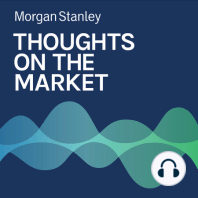3 min listen

Mike Wilson: Six More Weeks of Slow Growth
Mike Wilson: Six More Weeks of Slow Growth
ratings:
Length:
4 minutes
Released:
Feb 7, 2022
Format:
Podcast episode
Description
As we head towards the final weeks of winter, we are predicting a period of continued slow growth. As evidence we look not to our shadow but at earnings estimates and inventories.----- Transcript -----Welcome to Thoughts on the Market. I'm Mike Wilson, Chief Investment Officer and Chief U.S. Equity Strategist for Morgan Stanley. Along with my colleague bringing you a variety of perspectives, I'll be talking about the latest trends in the financial marketplace. It's Monday, February 7th at 11:30 a.m. in New York. So let's get after it.In the United States, February 2nd is known as Groundhog Day. A 135-year-old tradition of taking a groundhog out of his cage to determine if he can see his shadow. In short, a sunny February 2nd means six more weeks of winter, while a cloudy day suggests an early spring. Well, last week the most famous groundhog, who lives in Pennsylvania, saw his shadow informing us to expect more cold weather for six more weeks. While this tradition lives on, its track record is pretty spotty with a 50% hit rate. Flipping a coin sounds a lot easier. However, it does jive with our market forecast for at least six more weeks of winter, and ice, as growth slows further into the spring. Signs of weakness are starting to appear, and we think they go beyond Omicron. While we remain optimistic that this could be the final major wave of the pandemic, we're not so sure growth will rebound and accelerate as many others are suggesting.First, fourth quarter earnings beat rates are back to 5%, which is the long-term average. However, this is well below the beat rates of 15-20% observed over the past 18 months, a period of over earning in our view. The key question now is whether we are going to return to normal, or will we experience a period of under earning first, or payback? We've long held the view that payback was coming in the first half of 2022 as the extraordinary fiscal stimulus faded, monetary policy tightened, and supply caught up with demand in many end markets. Over the past few weeks several leading companies that weren't supposed to see this payback have disappointed with weaker than expected guidance on earnings. These stocks sold off sharply, and we think there are likely more disappointments to come as consumption falls short of expectations. Consumer confidence remains very soft due to higher prices, with our recent proprietary surveys suggesting consumers are expecting to spend more on staples categories over the next six months, versus the last six months. Spending on durables, consumer electronics and travel/leisure is expected to decline for lower income cohorts in particular.Second, inventories are now building fast and driving strong economic growth. However, the timing of this couldn't be worse if demand is fading more than expected. As noted in prior research, we think it could also reveal the high amounts of double ordering across many different industries. If that's correct, we are likely to see order cancelations, and that will only exacerbate the already weakening demand. In short, this supports a period of under-earning by companies as a mirror image to the past 18 months when inventories were lean and pricing power was rampant.Of course, the good news is that this likely means inflation pressures will ebb as companies lose pricing power. Eventually, this will lead to a more sustainable situation for the consumer and the economy. However, we think this could take several quarters before it's finally reflected in either earnings growth forecasts, valuations, or both. What this means for the broader market is probably six more weeks of downward bias. We continue to target sub-4000 on the S&P 500 before we would get more interested in trying to call an end to this ongoing correction. In the meantime, favor a defensive positioning. We've taken a more defensive posture in our recommendation since publishing our year ahead outlook in mid-November. Since then, it's paid off, although it hasn't been c
Released:
Feb 7, 2022
Format:
Podcast episode
Titles in the series (100)
Mike Wilson: Are U.S. Economic Indicators Flashing Yellow? by Thoughts on the Market